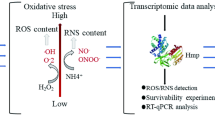Abstract
A wide-host-range plasmid pTRUS containing a homologous rus gene under the control of Ptac promoter was constructed and transferred into Acidithiobacillus ferrooxidans ATCC19859 using conjugation gene transfer method to generate the engineered strain of A. ferrooxidans(pTRUS). The plasmid-based recombinant rus gene was successfully expressed. According to the results of real-time quantitative PCR assay, not only the transcription level of recombinant rus gene but also the transcription levels of the other genes of rus operon (cyc1, orf, coxB, coxA) were increased in A. ferrooxidans(pTRUS). The ferrous ion (Fe2+) oxidation activity was increased in A. ferrooxidans(pTRUS).



Similar content being viewed by others
References
Bengrine A, Guiliani N, Appia-Ayme C, Jedlicki E, Holmes DS, Chippaux M, Bonnefoy V (1998) Sequence and expression of the rusticyanin structural gene from Thiobacillus ferrooxidans ATCC 33020 strain. Biochim Biophys Acta 1443:99–112
Carlos C, Reis FC, Vicentini R, Madureira DJ, Ottoboni LM (2008) The rus operon genes are differentially regulated when Acidithiobacillus ferrooxidans LR is kept in contact with metal sulfides. Curr Microbiol 57:375–380
Castelle C, Guiral M, Malarte G, Ledgham F, Leroy G, Brugna M, Giudici-Orticoni MT (2008) A new iron-oxidizing/O2-reducing supercomplex spanning both inner and outer membranes isolated from the extreme acidophile Acidithiobacillus ferrooxidans. J Biol Chem 283:803–811
Cox JC, Boxer DH (1978) The purification and some properties of rusticyanin, a blue copper protein involved in iron(II) oxidation from Thiobacillus ferrooxidans. Biochem J 174:497–502
Davison J, Heusterspreute M, Chevalier N, Ha-Thi V, Brunel F (1987) Vectors with restriction site banks. V. pJRD215, a wide-host-range cosmid vector with multiple cloning sites. Gene 51:275–280
Garcia FJ, Rubio A, Sainz E, Gonzalez P, Lopez FA (1994) Preliminary study of treatment of sulphuric pickling water waste from steelmaking by bio-oxidation with Thiobacillus ferrooxidans. FEMS Microbiol Rev 14:397–404
Herrera L, Ruiz P, Aguillon JC, Fehrmann A (1989) A new spectrophotometric method for the determination of ferrous iron in the presence of ferric iron. J Chem Technol Biotechnol 44:171–181
Iwahori K, Takeuchi F, Kamimura K, Sugio T (2000) Ferrous iron-dependent volatilization of mercury by the plasma membrane of Thiobacillus ferrooxidans. Appl Environ Microbiol 66:3823–3827
Liu Z, Guiliani N, Appia-Ayme C, Borne F, Ratouchniak J, Bonnefoy V (2000) Construction and characterization of a recA mutant of Thiobacillus ferrooxidans by marker exchange mutagenesis. J Bacteriol 182:2269–2276
Malarte G, Leroy G, Lojou E, Abergel C, Bruschi M, Giudici-Orticoni MT (2005) Insight into molecular stability and physiological properties of the diheme cytochrome CYC41 from the acidophilic bacterium Acidithiobacillus ferrooxidans. Biochemistry 44:6471–6481
Mercier G, Chartier M, Couillard D, Blais JF (1999) Decontamination of fly ash and used lime from municipal waste incinerator using Thiobacillus ferrooxidans. Environ Manag 24:517–528
Peng JB, Yan WM, Bao XZ (1994) Plasmid and transposon transfer to Thiobacillus ferrooxidans. J Bacteriol 176:2892–2897
Quatrini R, Appia-Ayme C, Denis Y, Jedlicki E, Holmes DS, Bonnefoy V (2009) Extending the models for iron and sulfur oxidation in the extreme Acidophile Acidithiobacillus ferrooxidans. BMC Genomics 10:394
Rawlings DE (2002) Heavy metal mining using microbes. Annu Rev Microbiol 56:65–91
Ramírez P, Guiliani N, Valenzuela L, Beard S, Jerez CA (2004) Differential protein expression during growth of Acidithiobacillus ferrooxidans on ferrous iron, sulfur compounds, or metal sulfides. Appl Environ Microbiol 70:4491–4498
Sezonov G, Joseleau-Petit D, D’Ari R (2007) Escherichia coli physiology in Luria–Bertani broth. J Bacteriol 189:8746–8749
Simon R, Priefer U, Pühler A (1983) A broad host range mobilization system for in vitro genetic engineering: transposon mutagenesis in Gram negative bacteria. Nat Biotechnol 1:784–791
Sugio T, Taha TM, Kanao T, Takeuchi F (2007) Increase in Fe2+-producing activity during growth of Acidithiobacillus ferrooxidans ATCC23270 on sulfur. Biosci Biotechnol Biochem 71:2663–2669
Yarzábal A, Appia-Ayme C, Ratouchniak J, Bonnefoy V (2004) Regulation of the expression of the Acidithiobacillus ferrooxidans rus operon encoding two cytochromes c, a cytochrome oxidase and rusticyanin. Microbiology 150:2113–2123
Zhao Q, Liu XM, Zhan Y, Lin JQ, Yan WM, Bian J, Liu Y (2005) Construction of an engineered Acidithiobacillus caldus with high-efficiency arsenic resistance. J Microbiol 45:675–679 (in Chinese)
Acknowledgments
This study was supported by the Chinese National Basic Research Program (2004CB619202, 2010CB630902), the National High Technology Research and Development Program (2007AA06A407), and the Knowledge Innovation Program of CAS (2AKSCX2-YW-JS401). The authors thank Dr. Roberta Greenwood for her help in editing this manuscript.
Author information
Authors and Affiliations
Corresponding author
Rights and permissions
About this article
Cite this article
Liu, W., Lin, J., Pang, X. et al. Overexpression of Rusticyanin in Acidithiobacillus ferrooxidans ATCC19859 Increased Fe(II) Oxidation Activity. Curr Microbiol 62, 320–324 (2011). https://doi.org/10.1007/s00284-010-9708-0
Received:
Accepted:
Published:
Issue Date:
DOI: https://doi.org/10.1007/s00284-010-9708-0




